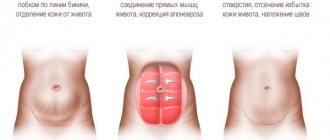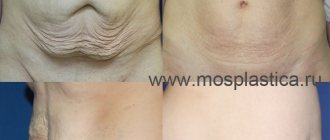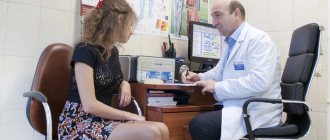Abdominoplasty is the best solution for correcting your abdomen!
With age, both men and women (especially after pregnancy and childbirth) change the shape and size of the abdomen. Fat deposits appear, the skin becomes flabby, the tissues become loose and overstretched. As a result, the appearance of the abdomen, unfortunately, is far from ideal, and this significantly reduces the quality of life. The most effective way to “remove the belly” is plastic surgery – abdominoplasty.
| Before | After |
The goal of abdominoplasty is to restore the youthful, toned shape of the abdomen, form an aesthetic navel and adjust the waistline, making it more prominent.
Indications for tummy tuck:
- overstretched, loose skin in the abdominal area, the presence of stretch marks after childbirth;
- excess fatty tissue on the abdomen and waist (the so-called “skin-fat apron”);
- muscle weakness of the anterior abdominal wall (overstretched muscles after pregnancy).
Unfortunately, any therapeutic treatment (diet, sports, cosmetic procedures) for the above aesthetic deficiencies will be ineffective. The only way to radically solve the problem is tummy tuck in combination with electronic lipomodeling and laser liposuction.
With small excess skin and the volume of “excess fat” no more than 2 liters, you can limit yourself to liposuction, but its results will still not be as effective. If your goal is a flexible torso and a sporty, toned stomach, then you cannot do without plastic surgery.
By the way, a flat stomach is not only beautiful, but also beneficial for our body, because... strong abdominal muscles (pumped up abs) support the diaphragm in a high position, preventing the internal organs from descending. Women who have lost muscle tone due to pregnancy and childbirth can only restore them through surgery.
Model belly! What can abdominoplasty do?
Modern beauty standards are particularly demanding of a slim figure. Since nature and motherhood sometimes change the figure for the worse, people resort to various methods of losing weight and improving certain areas of the body. If sports, fitness and diets do not help, abdominoplasty can help. We talk about what kind of operation this is, how to prepare for it and maintain the postoperative effect with Petr Viktorovich Shelest, Candidate of Medical Sciences, plastic surgeon at the Expert Clinic Irkutsk.
— Pyotr Viktorovich, what is abdominoplasty? What is it for?
— Abdominoplasty is an operation to correct the anterior abdominal wall. It may be necessary for women after pregnancy and childbirth, after significant weight loss, in the presence of excess skin and fat deposits, as well as serious scar changes on the anterior wall of the abdomen.
— Tell us about the existing types of abdominoplasty and their differences.
— There are many methods for performing this operation. Conventionally, there are two large groups – mini abdominoplasty and true (full) abdominoplasty. They differ in that in the first case the surgical intervention does not involve moving the navel, and in the second it is performed with moving the navel.
Full abdominoplasty is accompanied by plastic surgery of the anterior abdominal muscles, removal of hernial protrusions, excess skin and subcutaneous fat with navel transfer.
Mini abdominoplasty is used much less frequently and is indicated for women at a young age in the absence of sagging skin on the abdomen.
People with severe abdominal obesity, as well as women after several births, may experience separation of the rectus abdominis muscles - diastasis. In this case, abdominoplasty is performed to eliminate diastasis of the rectus abdominis muscles. Occasionally, it is necessary to perform endoscopic abdominoplasty using special equipment through small punctures in the anterior wall of the abdomen.
The operation is performed under general anesthesia. Depending on the type of intervention, its duration ranges from one and a half to four hours.
— Is abdominoplasty a procedure only to eliminate cosmetic defects or can it be prescribed for therapeutic purposes?
— Despite the fact that abdominoplasty is performed only by plastic surgeons, this operation not only helps to correct cosmetic defects, but also has therapeutic purposes, namely, the elimination of discrepancies in the rectus abdominis muscles and hernias, if any. In addition, pronounced deforming scars on the abdomen can cause pain to patients, so their removal leads to both a cosmetic and therapeutic effect.
— How do patients prepare for tummy tuck?
— Usually, a few days before the procedure, a comprehensive examination is carried out, including not only general blood tests, urine tests and an assessment of the cardiovascular and respiratory systems, but also an ultrasound of the abdominal organs. If the patient suffers from a concomitant pathology, consultations with related specialists - a gynecologist, endocrinologist, nutritionist and others - may be necessary.
— What recommendations do you give to patients after abdominoplasty?
— On the first day after surgery, patients must lie down, the next day they are allowed to get up and walk around the ward. During the early recovery period (within two weeks, when dressings are performed), you must be extremely attentive to your health. It is at this time that complications may arise, in particular, a seroma (accumulation of tissue fluid) may form, which must be removed in a timely manner.
I would like to note that during the period of early rehabilitation it is recommended to sit as little as possible; you should try to either lie down or walk.
In the next two months after abdominoplasty, it is mandatory to wear compression garments, namely a postoperative bandage. During the first month, I recommend wearing it around the clock without taking it off, after which it is acceptable to unfasten it at night. For six months, there remains a restriction on lifting weights of up to five kilograms.
Six months after this intervention, patients return to everyday life. It is important to continue to ensure that physical activity is moderate and nutrition is balanced.
— How long does the effect of the operation last?
— It directly depends on the patient himself. If after it he leads a healthy active lifestyle, then the effect will be lifelong. Excessive exercise, poor nutrition, excess weight gain, and physical inactivity can negate the results obtained after surgery.
— Are there any contraindications to abdominoplasty?
- Yes. One of the main ones is obesity. In addition, surgical correction of the anterior abdominal wall is not performed on patients with chronic diseases in the acute stage: diabetes mellitus, decompensated arterial hypertension, coronary heart disease, and some diseases of the respiratory system.
The psychological status of the patient is also extremely important. He must clearly understand what he wants and what he can get from the operation. Therefore, our clinic always conducts a preliminary conversation with patients, where they receive answers to all their questions.
For reference:
Shelest Pyotr Viktorovich
In 2000 he graduated from the medical faculty of Irkutsk State Medical University.
In 2002, he completed his clinical residency in surgery.
Since 2008 he has been practicing plastic surgery. Candidate of Medical Sciences.
He is the chief freelance plastic surgeon at the Ministry of Health of the Irkutsk Region.
He holds the position of Deputy Chief Physician for Surgery at Clinic Expert Irkutsk. Receives at the address: st. Kozhova, 9A.
“Muscle corset”: about the essence of the abdominoplasty technique
Depending on the amount of excess fat, excess skin, and the degree of muscle overextension, there are three types of abdominoplasty. The technique is the same for all types, the difference is in the volume of work of the surgeon:
- aesthetic abdominoplasty (performed for patients with slight excess skin in order to improve the appearance of the scar after cesarean section),
- abdominoplasty in patients who are not overweight (deformed abdomen due to overstretched skin after pregnancy, with a large number of stretch marks),
- volumetric abdominoplasty (done for patients of a large weight category, can be combined with multi-stage liposuction).
So, when starting to correct the abdomen, the plastic surgeon must first remove fat deposits (if any) from problem areas: abdomen, waist, back. Liposuction is performed either in the preoperative period or as the first stage of abdominoplasty.
Tummy tuck is performed under general anesthesia and the operation lasts about 3 hours. Abdominoplasty of the upper flap, proposed by Dr. Pascal (France) is the most popular and safe technique, since after it the stomach looks very natural. It is not surprising that most clinics in Russia and abroad choose it.
During abdominoplasty, a horizontal incision is made in the bikini area and in the navel area. The main manipulations take place at the level of the aponeurotic layer of muscles in the abdominal region. The surgeon’s task is to tightly stitch these overstretched abdominal muscles together, i.e. actually “tighten” the patient “into a corset”, which will be located inside and keep the shape of the abdomen and waist. After this, the skin is stretched, straightened, its excess is removed and sutures are applied. The surgeon does the main stretching of the skin in the navel area (the scar is hidden in a natural depression), this creates comfortable conditions for the healing of the lower visible scar.
Rehabilitation period: healing without problems!?
Abdominoplasty is a fairly traumatic operation, after which the patient must go through a long period of rehabilitation.
The first abdominoplasty techniques disrupted the blood supply to the abdominal area and created strong tension on the skin; as a result, the scar in the bikini area took months to heal, it stretched and deformed, causing a lot of trouble for the patient.
The latest achievements of plastic surgery, the use of our own proprietary methods of working with the anterior abdominal wall, reducing the trauma of surgical intervention, preserving the feeding blood and lymphatic vessels, applying special unloading sutures - all this has made abdominoplasty in the 21st century a safe operation with good aesthetic results.
After tummy tuck, the patient spends 3-5 days in the clinic’s hospital. The sutures are removed at 10-12 days. Patients wear a special support bandage or corset for about 4-8 weeks. During this time, it is necessary to exclude any physical activity (lifting weights, for example).
Bruising and swelling in the abdominal area will persist for several weeks after surgery. Therefore, in our clinic we carry out a set of rehabilitation procedures that relieve post-traumatic syndrome and promote faster healing of scars: magnetic therapy, ultrasound therapy, laser therapy, microcurrent therapy, mesotherapy, etc.
Typically, after a couple of weeks the patient can return to his daily activities. However, the full course of rehabilitation lasts about 1.5-2 months.
The scar in the bikini area turns white and becomes barely noticeable only after 6-12 months. If its appearance is far from perfect (which is possible with abdominoplasty), then plastic surgeons will offer to correct the scar a year after abdominoplasty.
The patient’s attentive and careful attitude towards his operated abdomen and scar, strict adherence to all the doctor’s recommendations is the key to a successful result of abdominoplasty.
Price list "Intimate plastic surgery"
GYNECOLOGICAL OPERATIONS
| Preoperative examination and anesthesia (anesthesia) are not included in the cost of the operation and are paid separately! | |
| RECEPTIONS AND CONSULTATIONS | |
| Initial appointment with a gynecologist surgeon | 1100 rub. |
| Repeated appointment with a gynecologist-surgeon | 900 rub. |
| Appointment for the selection of a vaginal gynecological pessary by Dr. Arabin for the treatment of prolapse of the uterus and vaginal walls | 1300 rub. |
| Consultation with a gynecological surgeon before hysteroscopy, on intimate plastic surgery and reconstructive operations: Labiaplasty, Perineoplasty, Colporrhaphy, Cervicoplasty, etc. (without examination on the chair) | 700 rub. |
| Preparation of an extract from an outpatient card | 250 rub. |
| GYNECOLOGICAL OPERATIONS | |
| Perineoplasty - correction of perineal deformity, restoration of normal perineal anatomy after ruptures during childbirth | 39400 rub. |
Labiaplasty - cosmetic and therapeutic plastic surgery of the labia minora, intimate plastic surgery
|
|
| Cervicoplasty - restoration of normal anatomy of the cervix after ruptures during childbirth | 29600 rub. |
| Anterior colporrhaphy - surgical reconstruction of the pelvic floor with one’s own tissues in case of prolapse (prolapse) of the anterior wall of the vagina and bladder | 39700 rub. |
| Posterior colporrhaphy with sphinctero-levatoroplasty and perineoplasty - surgical reconstruction of the pelvic floor with one’s own tissues in case of prolapse (prolapse) of the posterior wall of the vagina and rectum | 59000 rub. |
| Dressing under local anesthesia, suture removal | 1000 rub. |
ANESTHESIOLOGICAL ASSISTANCE (NARCOSITION)
| LOCAL ANESTHESIA | |
| Local infiltration and conduction anesthesia Ultracain | 500 rub. |
| Local infiltration and conduction anesthesia Lidocaine | 250 rub. |
| GENERAL ANESTHESIA | |
| Intravenous anesthesia with spontaneous breathing for up to 30 minutes. (diagnostic and short-term operations) | 4000 rub. |
| Intravenous anesthesia with spontaneous breathing for operative hysteroscopy | 3500 rub. |
| Intravenous anesthesia with spontaneous breathing for more than 30 minutes, up to 60 minutes (1 hour) | 6000 rub. |
| Intravenous anesthesia with spontaneous breathing for over 60 minutes. (over 1 hour), every additional 30 minutes. | 3000 rub. |
Back to contents
About the results of tummy tuck
After abdominoplasty, patients will have to completely change their wardrobe! But for most people who have undergone tummy tuck, it’s a joy: they still have to go shopping and buy clothes several sizes smaller...
The results of abdominoplasty last for life. Even if the patient begins to gain weight after surgery, fat deposits on the abdomen will be minimal.
Since modern abdominoplasty techniques make the stomach and navel area as natural as possible, you can safely expose this part of the body and wear a two-piece swimsuit. Of course, a scar will remain in the bikini area, but by choosing the right open swimsuit and underwear, it will be easy to keep it secret from prying eyes!
Plastic surgery of the labia minora
Labiaplasty is a surgical method for aesthetic correction of the size and shape of the labia.
The labia are an intimate (hidden) part of the body. There are no generally accepted canons of beauty in this area, however, the sexual attractiveness of this area for a woman and her partner is of great importance, especially for the labia minora.
Indications for labiaplasty can be medical or aesthetic. For aesthetic reasons, labiaplasty is performed when a woman is dissatisfied with the shape or size of the labia minora.
Medical indications include situations when a woman complains of physical and psychological discomfort; congenital or acquired asymmetry of the labia; deformation of the labia after injuries, operations, burns, etc.
As a result of the operation, the optimal size and shape of the labia is restored, congenital or acquired defects are corrected. Read more about labiaplasty in this article .
Back to contents
Abdominoplasty at the Anthurium clinic
The Anthurium Clinic, having a high technical level of operating room equipment, has been successfully correcting the shape and size of the abdomen of any complexity since 2004. Plastic surgeons, combining abdominoplasty with electronic lipomodeling and laser liposuction, achieve good aesthetic results and give their patients a flat, athletic stomach.
Understanding the need for a rehabilitation course after abdominoplasty, the Anthurium clinic performs the first cosmetic procedure free of charge.
The aesthetic effect of abdominoplasty impresses everyone! After tummy tuck, you will remember the forgotten feeling of lightness and fit of your figure, and the next beach season will confirm the correctness of your decision!









